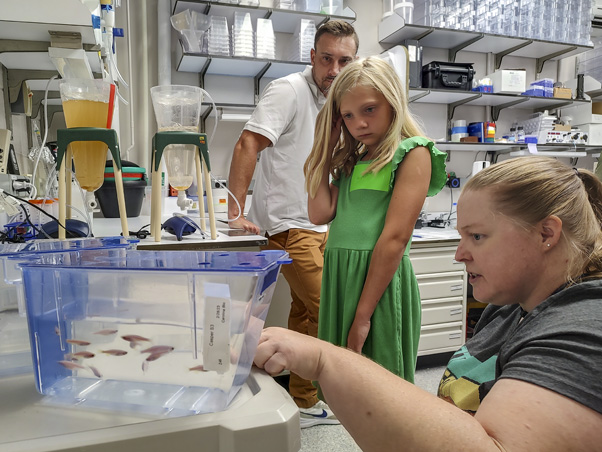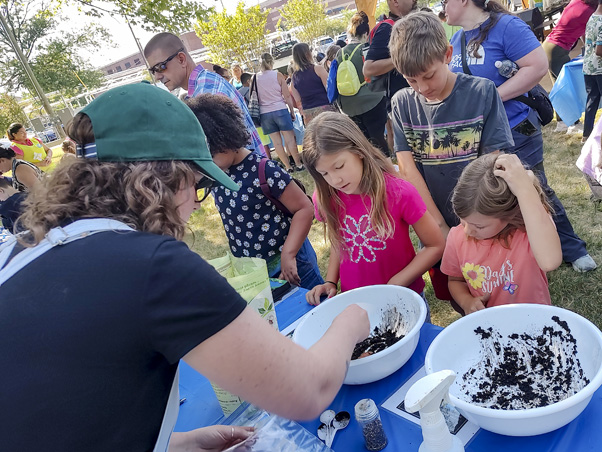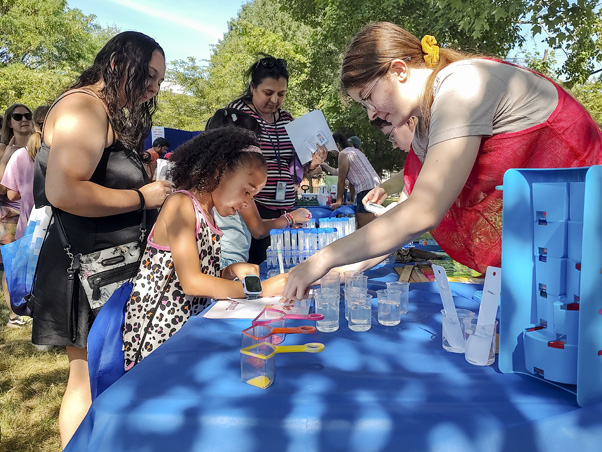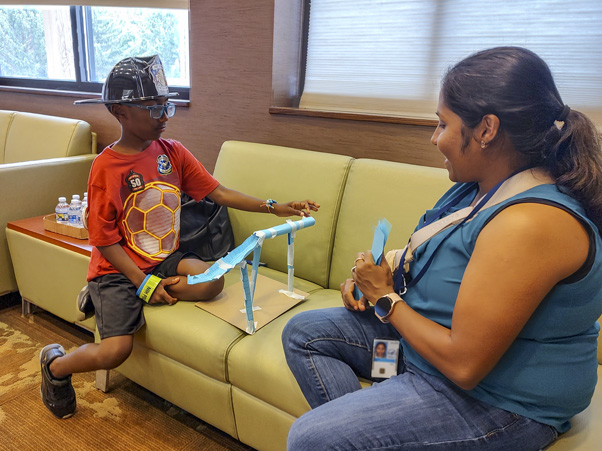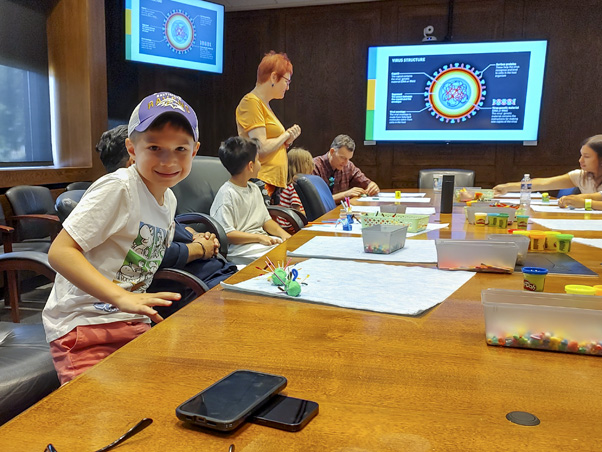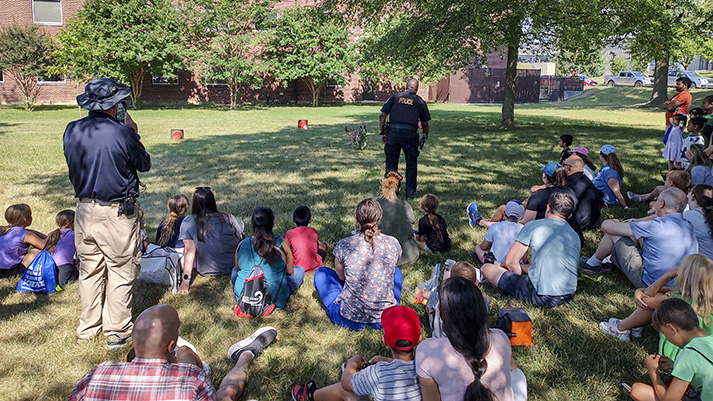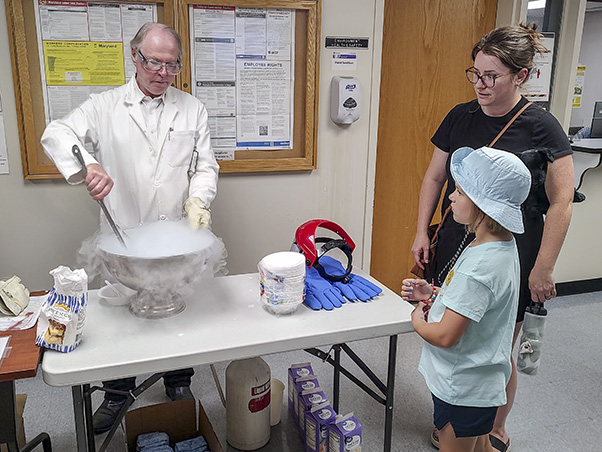Genevieve Burns and her teammates watched as another team’s tiny robotic car collided with their own. Then the shouting started.
“Get out of our way!” came the gleefully impatient cries from both teams. “Move it, people! Move it!”
The amateur programmers—none older than 13—turned to their laptops, small hands hurriedly pressing controls to escape the Asimovian fender-bender. The cars swerved free and trundled forward. Pins secured to their front bumpers, they aimed anew for their targets: a handful of nearby balloons.
Pop! The room erupted into cheers as one of the cars found its mark, Burns and her teammates even joining in to celebrate their competitors.
Take Your Child to Work Day was no place for grudges, after all, spirited competition notwithstanding.
NCI Frederick hosted the event in June and, according to the Office of Scientific Operations, saw a larger turnout than last year by a wide margin. The campus was ready for the crowds, with droves of employees and interns volunteering to teach kids about science through a day of interactive programs.
The robotics session that Burns attended, “Robotech Rally: Dive into Programming and Robotics,” was one of more than two dozen activities. It let participants take turns programming and piloting the robotic cars to navigate a simple obstacle (a path requiring two turns) and, for the grand finale, attack a gallery of balloons.
Burns and her teammates rebounded from their inconvenient collision and went on to pop a large share of the colorful targets. For her, a first-time attendee at Take Your Child to Work Day, it was more than just fun. She said she’s interested in robotics because it lets people use their imaginations to innovate and create new things.
“It’s way better than I thought,” she said when asked about the day. “It’s amazing, and [other kids] should come.”
Burns also enjoyed seeing and getting to explore the different buildings at NCI Frederick—with supervision, of course—as she traveled between programs. There was no shortage of chances for that, given the number of groups across campus that sponsored activities this year.
Science Seen Up Close
In one such building, Harper Breakall was becoming a zebrafish doctor. She and four other children took turns at three microscopes, identifying fish eggs, monitoring a fish’s pulse, and pinpointing which fish were ill.
The program, “Zebrafish: Making a Big Splash in Human Disease,” focused on the Laboratory of Cell and Developmental Signaling’s specially bred fish colonies, especially their translucent “Casper fish.” The fish are excellent models for human pediatric cancers because they develop quickly and share many genes with humans, the lab staff said. Their translucence also makes it easier to study their organs and notice internal physiological changes.
Breakall, who was attending Take Your Child to Work Day for her second year, paired off with one of the scientists to spend a few minutes studying the fish. Afterward, she said, “I think it’s really awesome” when asked about the event.
Obvious Prizes, Subtle Prizes
Bailey Rice, meanwhile, was on a mission, although one wouldn’t have guessed that by looking at her. Seated in the Scientific Library, the self-proclaimed crafts enthusiast contentedly and skillfully made a badge sporting an image of a butterfly as part of the library’s pollinator-themed arts and crafts activities. It was only upon striking up a conversation that one learned of her ambition to clinch a promised “mystery prize” for collecting a stamp from each of the day’s hub activities.
The 8-year-old outlined her jam-packed itinerary worthy of a travel agent. She’d finish at the library, return to the hub area and watch the NIH K9 unit demonstration, dash over to Building 426 for a must-have bowl of liquid nitrogen ice cream, take a quick break for lunch, squeeze in a few more activities before her last program of the day, and finish the rest afterward.
But Rice and her fellow kids were already earning or making other prizes. By the end of the day, she’d acquired a literal trunkload, ranging from her handcrafted miniature rollercoaster to a catapult for launching marshmallows to a canvas tote bag she decorated with bubble paint. All of it hinted at the real prize, which was what she’d learned about biology, chemistry, and physics.
“It’s super fun,” she said.
Looking Forward to Next Year
First-time attendee Bawan Ramadhan was one of the eager participants who claimed the mystery prize at the end of the day. Entering the Building 549 lobby, he triumphantly showed Carrie Wagerman, NCI Office of Scientific Operations, his stamp-filled activities booklet and—in exchange—got to take an ice pop from an assortment of fruit-flavored choices.
He’d just come from his last program, “The Wonderful World of Viruses,” a look at viruses’ biology and effects on human health. For the hands-on component, he and the other participants used modeling clay and miscellaneous craft supplies to make models of their own viruses. Then they had to explain the symptoms experienced by someone who contracted their virus, often with truly imaginative answers. Ramadhan said his makes people grow a beard.
“I’m still energized,” he said, clasping his grape ice pop in the lobby. He added that anyone who attends should “do as many fun things as [they] can possibly do.”
He was ready to step out into the sunny afternoon heat, but before he left, he said whether he’d be back for next year’s event. His answer was the same as so many children throughout the day.
It was, emphatically, Yes.
Take Your Child to Work Day was coordinated by Tori Seal and colleagues in the NCI Frederick Office of Scientific Operations, along with the Take Your Child to Work Day Committee. Data Management Services handled registration and check-in. The committee invites attendees to submit feedback.
Samuel Lopez leads the editorial team in Scientific Publications, Graphics & Media (SPGM). He writes for newsletters; informally serves as an institutional historian; and edits scientific manuscripts, corporate documents, and sundry other written media. SPGM is the creative services department and hub for editing, illustration, graphic design, formatting, multimedia, and training in these areas.



